Search the Special Collections and Archives Portal
Search Results
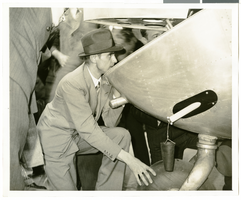
Photograph of Howard Hughes behind his plane at Le Bourget Airfield, France, July 1938
Date
1938-07
Archival Collection
Description
Description printed on photograph's accompanying strip of paper: "Checking damages of plane on arrival at Le Bourget. Le Bourget-- The thoroughness with which he planned the flight and carried it through was still with Howard Hughes when the millionaire flyer and his four companions arrived at Le Bourget, after a record smashing flight across the Atlantic. Hughes is shown here, examining the tail of his plane, just after landing, The tail was damaged slightly. After repairs were made, the fliers took off for Moscow."
Image
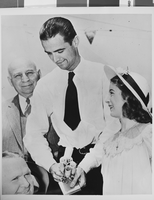
Photograph of a parade for Howard Hughes, Texas, 1938
Date
1938
Archival Collection
Description
Howard Hughes standing in between two unidentified individuals at a parade dedicated to Howard Hughes in Texas.
Image
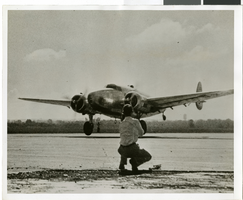
Photograph of Howard Hughes's plane taking off, Minneapolis, Minnesota, July 14, 1938
Date
1938-07-14
Archival Collection
Description
The black and white view of the Lockheed 14 aircraft taking off on a part of Howard Hughes' Around the World flight. Typed onto a piece of paper attached to the image: "Howard Hughes plane taking off from Minneapolis."
Image
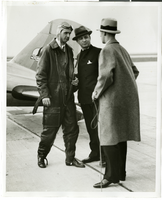
Photograph of Howard Hughes, Albert Lodwick, and unidentified man at Floyd Bennett Field, New York, April 21, 1936
Date
1936-04-21
Archival Collection
Description
Howard Hughes, Albert Lodwick, and an unidentified man at Floyd Bennett Field after record flight from Miami to New York.
Image
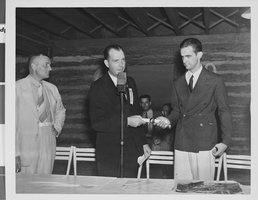
Photograph of a banquet for Howard Hughes, Texas, 1938
Date
1938
Archival Collection
Description
An unidentified man handing Howard Hughes a certificate during a banquet dedicated to Howard Hughes in Texas.
Image
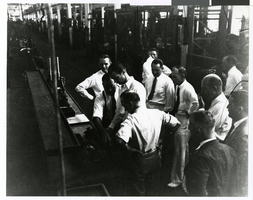
Photograph of Howard Hughes examining machinery at the Hughes Tool Company, 1938
Date
1938
Archival Collection
Description
Howard Hughes (taller man at left) examining machinery in Hughes Tool Company plant, 1938.
Image
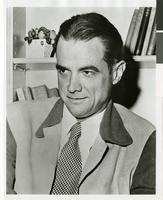
Photograph of Howard Hughes, circa 1935-1946
Date
1935 to 1946
Archival Collection
Description
An undated portrait of Howard Hughes.
Image
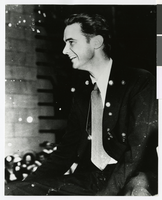
Photograph of Howard Hughes in profile, circa 1930s
Date
1930 to 1939
Archival Collection
Description
Portrait of Howard Hughes in profile.
Image
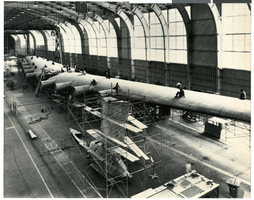
Photograph of the Hughes Flying Boat wing assembly, Culver City, California, circa 1942-46
Date
1942 to 1946
Archival Collection
Description
The Hughes Aircraft HK-1 or "Flying Boat" wing assembly being completed in a hangar in Hughes' factory in Culver City.
Image
Hughes, Otis A., 604 Avenue D., Boulder City, 1961
Level of Description
File
Archival Collection
Elmo C. Bruner Architectural and Real Estate Appraisal Records
To request this item in person:
Collection Number: MS-00177
Collection Name: Elmo C. Bruner Architectural and Real Estate Appraisal Records
Box/Folder: Box 15
Collection Name: Elmo C. Bruner Architectural and Real Estate Appraisal Records
Box/Folder: Box 15
Archival Component
Pagination
Refine my results
Content Type
Creator or Contributor
Subject
Archival Collection
Digital Project
Resource Type
Year
Material Type
Place
Language
Records Classification
